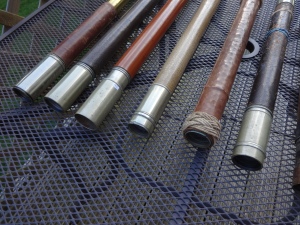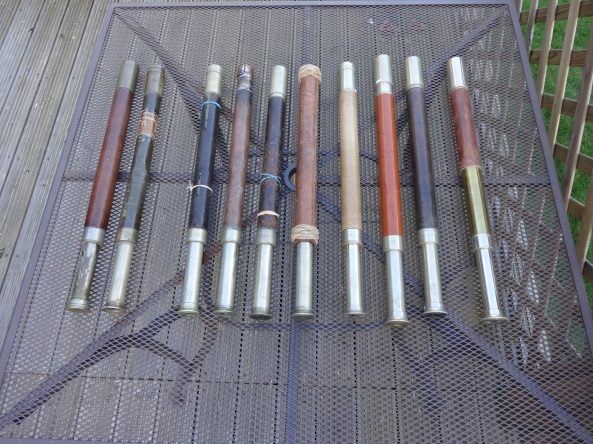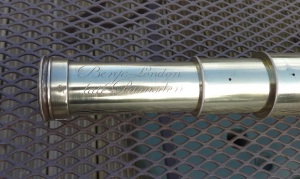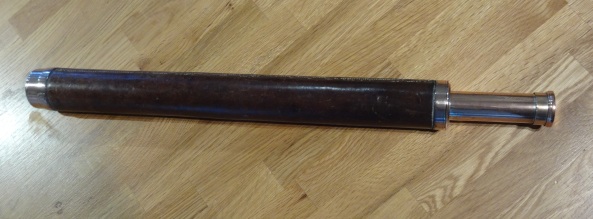There are a lot of these about, by definition. Go onto any warship and there are several of this style of telescope available for use – a prime example is behind the bridge on the Royal yacht “Britannia”, now moored up near Edinburgh, where the hooks/hoops hold about four of them in place. A few years ago I consciously bought some spares for this style, by buying old battered ones on Ebay. These, plus some better ones, are shown here – ten in total – and the mods illustrate how the basic design can be repaired with old conduit or whatever, as long as the lenses are still intact. One of these examples has been moulded over, such that it cannot be dismantled, but currently it still works!
Actually the diameters are not consistent between all these models, so lens swapping is not that simple. The manufacturers shown here are Ross, in many different eras, T. Cooke, Hammersley, and one that looks like a reseller, J. Coombes of Devonport (which latter has a interesting story, being engraved as owned by R D Graham). Actually J Coombes is quoted as an optical and instrument supplier to the Admiralty from the mid 19th Century onwards, so possible he did build the telescope. The quantities in which these were produced are illustrated by the serial numbers on some of the units. For example the T. Cooke models are numbers 5226, and then 6671, labelled on the sunshade, eyepiece, first draw etc.
 Then the four Ross units show the age progression, starting with one unit engraved as made by A. Rofs of London, in old script, with the “f” typical of late 18th or early 19th Century writing. This one has two crests on the end of the barrel, showing that it was presented by GRJ, with a king and crown image, to WBG, with a dove of peace image. A later unit is engraved in script, with a serial number 29155, and has the name Lieut Washer RNR engraved on the end of the barrel. This one is additionally engraved as sold by Seagrove and Co, of Portsea. There is then the moulded together unit engraved with ROSS in capital letters, and this is given serial number 31334: so there seem to have been a lot of these produced! 31334 has another much more interesting story, which will be recorded separately, as it was owned by Lt Cdr Francis Edmund Blechynden Haselfoot RN, active during WW1. I have actually forgotten to mention the other Ross unit here, bought for spares with no objective lens, although there is a lens somehow mounted half way along the main barrel! The rest of this barrel is really damaged. This is engraved as Ross London in script, with no serial number, on the eyepiece draw, so maybe is the second oldest. But actually the bezel has a name engraved on it, which has been almost totally wiped out with polishing. Again the name has a symbol above, maybe a tree branch around a bird again, similar to the one quoted above. After polishing and study it looks like the two words underneath could be Murray Gladstone. Andrew Ross worked mainly in Clerkenwell from 1830-1859: Ross & Co was used as the company name when they moved to Piccadilly, between 1839-1842. After 1859 Thomas Ross continued the business.
Then the four Ross units show the age progression, starting with one unit engraved as made by A. Rofs of London, in old script, with the “f” typical of late 18th or early 19th Century writing. This one has two crests on the end of the barrel, showing that it was presented by GRJ, with a king and crown image, to WBG, with a dove of peace image. A later unit is engraved in script, with a serial number 29155, and has the name Lieut Washer RNR engraved on the end of the barrel. This one is additionally engraved as sold by Seagrove and Co, of Portsea. There is then the moulded together unit engraved with ROSS in capital letters, and this is given serial number 31334: so there seem to have been a lot of these produced! 31334 has another much more interesting story, which will be recorded separately, as it was owned by Lt Cdr Francis Edmund Blechynden Haselfoot RN, active during WW1. I have actually forgotten to mention the other Ross unit here, bought for spares with no objective lens, although there is a lens somehow mounted half way along the main barrel! The rest of this barrel is really damaged. This is engraved as Ross London in script, with no serial number, on the eyepiece draw, so maybe is the second oldest. But actually the bezel has a name engraved on it, which has been almost totally wiped out with polishing. Again the name has a symbol above, maybe a tree branch around a bird again, similar to the one quoted above. After polishing and study it looks like the two words underneath could be Murray Gladstone. Andrew Ross worked mainly in Clerkenwell from 1830-1859: Ross & Co was used as the company name when they moved to Piccadilly, between 1839-1842. After 1859 Thomas Ross continued the business.
There are some people who have access to the records of these serial numbers, as used by Cooke and Ross, but as I don’t know how to see the records myself, any comment would be interesting! [Subsequently a correspondent – Richard Jeffries – helping his daughter research a family owned 1919 issued H Hughes & Son scope, located a book “The Officer of the Watch Telescope, 100 Years of Naval History” by Brian Buckman (2012). This book mentions that Ross serial numbers had reached 86,994 by 1940. Numbering started in 1842. Additionally NPL (the National Physical Laboratory, known in 1918 as the National Testing Laboratory) in their annual report for 1918, says they tested or checked for operation 11,133 scopes in 1916-17, 13,306 in 1917-18, and 7,967 in the first six months of the 1918-19 FY]
Description
 The typical design is for a 17” or 18” long barrel, with a 6” single draw to the eyepiece and approx a 1.5” objective lens. Typically the sunshade pulls out around 3”. The barrel is usually leather covered, but when that wears out it would get covered with whatever is available. One of the examples pictured seems to be half covered in leather, and half brass polished.
The typical design is for a 17” or 18” long barrel, with a 6” single draw to the eyepiece and approx a 1.5” objective lens. Typically the sunshade pulls out around 3”. The barrel is usually leather covered, but when that wears out it would get covered with whatever is available. One of the examples pictured seems to be half covered in leather, and half brass polished.
These scopes are easy to focus, easy to use, short enough not to hit anyone else or get in the way of colleagues on a small bridge, give a reasonable magnification, and are fit for purpose – ie use by the Officer of the Watch. Most of them seem to have been personalised, so maybe were purchased by the Officers themselves.
Who owned these?
OOW telescopes were mainly owned and used by naval personnel, on board ships in the Royal Navy, right through up to almost the present day. Probably modern binoculars started to take over from around the 1960s. But lets see what we know about these ten units:
* R D Graham was a single handed yachtsman sailing the Atlantic in the 1930s. See a later story.
* Lieut Washer was in the RNR, Royal Naval Reserve, presumably in WW1: there is a Lt George Edward Washer from NZ (Dunedin) quoted in the RNR war records for WW1, but no further info has been found. He was demobbed in 1919
* Lt Cdr Francis Edmund Blechynden Haselfoot RN commanded a ship in the North Sea in WW1. See a later story.
* The Cooke telescope 6671 was owned by Acting Lieutenant C Wright.
So these are all naval, or at least, associated with use at sea. There are two more that bear markings, and are interesting.
The “A Rofs” telescope

 The telescope dates from 1830-1840 let us say. The inscription on the bezel says GRJ to WBG. With a GRJ monogram, plus the image above of a an apparent monarch in ermine and with a crown, you think of King George V and VI, who actually used GRI, for George Rex Imperator, ie Emperor of India. But George IV, who died in 1830, was not the Emperor of India, and William IV followed him. But then this crown, is maybe not a crown, but some form of shrub or bush! Above the WBG there is an image of a bird, with relatively long legs, looking like a racing pigeon: it could even be a pheasant. In its beak it is holding what might be described as an olive branch: a short branch, or twig. [Editor’s note: For those that might ask, William Ewart Gladstone, the British Prime Minister was born in 1809 and died in 1898: but his initials were WEG]
The telescope dates from 1830-1840 let us say. The inscription on the bezel says GRJ to WBG. With a GRJ monogram, plus the image above of a an apparent monarch in ermine and with a crown, you think of King George V and VI, who actually used GRI, for George Rex Imperator, ie Emperor of India. But George IV, who died in 1830, was not the Emperor of India, and William IV followed him. But then this crown, is maybe not a crown, but some form of shrub or bush! Above the WBG there is an image of a bird, with relatively long legs, looking like a racing pigeon: it could even be a pheasant. In its beak it is holding what might be described as an olive branch: a short branch, or twig. [Editor’s note: For those that might ask, William Ewart Gladstone, the British Prime Minister was born in 1809 and died in 1898: but his initials were WEG]
The “Ross” telescope
 There are some parallels to the one above, with this further Ross telescope. We assume it is later than the one quoted above. It was bought for spares, with a barrel that is badly squashed and bashed about. But only in writing this have I noticed the engraving on the bezel. This is almost totally worn away, from frequent polishing, but the wording underneath has eventually been deciphered as Murray Gladstone. Above this name there is an image framed in an olive branch almost making a total frame (from 7pm to 5pm on a clock face) around what could be a bird, but this time on a mound or mountain. This is very indistinct. (Having taken the photo shown on the left, and studied it, the image could be of a woman in a dress – the skirts making the ‘mountain’ – or even an angel with wings behind).
There are some parallels to the one above, with this further Ross telescope. We assume it is later than the one quoted above. It was bought for spares, with a barrel that is badly squashed and bashed about. But only in writing this have I noticed the engraving on the bezel. This is almost totally worn away, from frequent polishing, but the wording underneath has eventually been deciphered as Murray Gladstone. Above this name there is an image framed in an olive branch almost making a total frame (from 7pm to 5pm on a clock face) around what could be a bird, but this time on a mound or mountain. This is very indistinct. (Having taken the photo shown on the left, and studied it, the image could be of a woman in a dress – the skirts making the ‘mountain’ – or even an angel with wings behind).
Now I did not know about Murray Gladstone before reading the name on this telescope. Google advises that he was, in fact, the first cousin of the British PM William E Gladstone, and he built a country mansion near Penmaenmawr in Wales, according to the Penmaenmawr Historical Society (thanks to David Bathers and Dennis Roberts). It cost him what would be £1m in today’s money: the house is today called Noddfa, which means a place of refuge and peace, but then was called Tan y Foel.
Murray Gladstone was a Manchester businessman who made his fortune in the Anglo-Indian textile trade. Tan y Foel was built as a country home with tennis courts, a nearby golf course and elegant gardens overlooking Liverpool Bay. He died tragically on the beach on Monday night the 23 August 1875. He allegedly suffocated in the shallow water after slipping off the rocks. It is alleged he had a few enemies in the locality, so maybe this is another mystery on the shores of Penmaenmawr: did he fall or was he killed?
[Editor’s note: Obviously one has to ask, was he perhaps using the telescope at the time? Did anyone think of this? Is that perchance how it, the telescope, became so bashed about, with him dropping it so carelessly on the rocks maybe? Was the guy who pushed him a robber who just wanted the telescope? Who put the telescope on Ebay anyway? But maybe it would not have been them, they would not have been around 140 years ago. I don’t think I kept a record of that anyway….]
It would have been a real coincidence had the A.Rofs telescope quoted first actually have been given to W.E.Gladstone!
What are OOW telescopes worth?
 It all depends on how much action they have seen, in more ways than one. If one has seen a lot of action, been dropped on the rocks or in the sea, or blown to pieces, it is not worth a lot. If it is in perfect condition, and works, and has no name, it will be worth £120-150. If it has a past owner that is recorded, maybe via an engraved owner’s name, and has possibly been associated with past events, it is worth more: and T. Cooke versions are better quality than the others. If you actually can find out what the owner did, who he was, and maybe whether the telescope was associated with his activities, then it is worth much more still, maybe £500 plus. Sadly I cannot see the Ross telescope from Murray Gladstone ever being worth a premium, and it will never work again: but it only cost me £10, plus postage. One of the eyepiece lenses is already in use on a T. Cooke model, serial 5226, one of the others quoted above!
It all depends on how much action they have seen, in more ways than one. If one has seen a lot of action, been dropped on the rocks or in the sea, or blown to pieces, it is not worth a lot. If it is in perfect condition, and works, and has no name, it will be worth £120-150. If it has a past owner that is recorded, maybe via an engraved owner’s name, and has possibly been associated with past events, it is worth more: and T. Cooke versions are better quality than the others. If you actually can find out what the owner did, who he was, and maybe whether the telescope was associated with his activities, then it is worth much more still, maybe £500 plus. Sadly I cannot see the Ross telescope from Murray Gladstone ever being worth a premium, and it will never work again: but it only cost me £10, plus postage. One of the eyepiece lenses is already in use on a T. Cooke model, serial 5226, one of the others quoted above!














